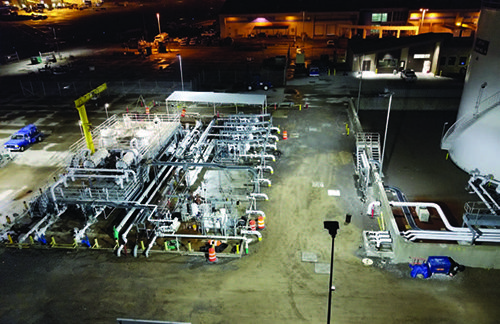The traffic profile at Nashville International (BNA) is completely different from what it was two decades ago, and a recent $30 million fuel farm renovation is helping the Tennessee airport handle the dramatic changes.
The traffic profile at Nashville International (BNA) is completely different from what it was two decades ago, and a recent $30 million fuel farm renovation is helping the Tennessee airport handle the dramatic changes.
 When BNA originally built its fuel farm in 1987, connecting flights associated with American Airlines’ mini-hub accounted for 80% of the airport’s overall traffic. After American de-hubbed in 1997, volume at BNA dropped quickly, and leveled off at about 7 million passengers. BNA would spend the next 16 years recovering; and by 2013, passenger traffic had reached 10.5 million. Since then, the airport has added about 1 million passengers per year, ultimately serving 14.1 million travelers in 2017. In addition, BNA is now the origin or final destination for approximately 88% of its passengers.
When BNA originally built its fuel farm in 1987, connecting flights associated with American Airlines’ mini-hub accounted for 80% of the airport’s overall traffic. After American de-hubbed in 1997, volume at BNA dropped quickly, and leveled off at about 7 million passengers. BNA would spend the next 16 years recovering; and by 2013, passenger traffic had reached 10.5 million. Since then, the airport has added about 1 million passengers per year, ultimately serving 14.1 million travelers in 2017. In addition, BNA is now the origin or final destination for approximately 88% of its passengers.
“It took 17 years to grow 3.5 million passengers; and since then, we’ve seen another 4 million in just four years,” summarizes Robert Ramsey, chief operating officer of the Metropolitan Nashville Airport Authority. “Nobody anticipated that kind of growth.”
|
facts&figures Project: Fuel Farm Renovation Location: Nashville (TN) Int’l Airport Airport Owner: Metropolitan Nashville Airport Authority Fueling Consortium: Nashville Fuel Co. (chaired by Southwest Airlines) Project Cost: $30 million Construction: Oct. 2016-April 2017 Project Manager: Argus Consulting Contractor: Meccon Industries Fuel Farm Manager: Menzies Aviation Key Components: New control & maintenance building; completely refurbished fuel tanks; automated gauges, valves, controls for tanks; new hydrant & transfer pumps; stormwater management upgrades; removal of abandoned underground tanks & lines |
Fortunately, the airport began the design process in 2013 to renovate its fuel farm. As traffic continued to increase at 1 million passengers per year, a project team was in position to begin construction in fall 2016. With a fully renovated facility on line last fall, BNA is keeping pace with the unprecedented growth it experienced in the last four years.
The timing of the project was fortuitous other ways, as it coincided closely with the end of American’s lease for the fuel facility and the beginning of Southwest Airlines assuming substantially more square footage at BNA. The Nashville Fuel Company, an airline consortium led by Southwest, was subsequently formed to manage the updated fuel facility—with the airport’s blessing and appreciation, notes Shane Thrasher, category manager of Fuel Infrastructure Management for Southwest.
BNA and Southwest agreed that the airlines should oversee
the airport’s fueling needs and worked to finalize a long-term lease for the consortium in 2016. A bridge loan from John Hancock provided initial capital while the consortium secured full funding for the project.
“We’re not fueling experts, and there were a number of repairs to be completed,” says Ramsey. “The facility was 30 years old and needed to be updated. And, if there is a lack of fuel, that may mean there is not expansion or additional flights. Even though we’re not directly in that chain, we are impacted by it.”
Establishing Objectives
The airport hired Argus Consulting to determine the scope of work needed, and the firm performed a full assessment of the pipeline receiving systems, storage facilities, truck operations, buildings and emergency shutoff system.

Ramsey emphasizes that airports should never skip the assessment stage. “No one wants to be associated with a leak from a fuel farm. It’s bad for the environment and bad for us,” he remarks, noting that environmental regulations had changed throughout the years.
Eight months before the fueling consortium was formed, Menzies Aviation was brought on board to manage the updated facilities. Bryan Hubbard, the company’s general manager at BNA, notes that it took years of legwork to negotiate, project future usage levels, formulate the scope of construction and design, and subsequently complete the engineering and design phases. “The planning and resolution phases brought everyone together and really helped create a strong relationship between all parties,” he recalls. “Once the projects got started, the work progressed very quickly.”
Although renovating the fuel farm was not one of BNA’s most expensive projects to date, it was one of the largest and most challenging in terms of the work scope and amount of equipment that was replaced. It also required the team to navigate a high level of complexity, adds Hubbard.
Modern Amenities
 Jeremy Dieckhoff, civil discipline manager with Argus, says that the recent top-down restoration of BNA’s fuel farm yielded a modern facility that is prepared for the future. All tanks were completely refurbished, stripped and recoated. New technology was implemented through tank gauging, automatic valves, control systems, etc. And all hydrant system and transfer pumps were replaced. As a result, fuel transfer times have been cut in half, he reports. Previously, it took nearly 18 hours to drain a tank.
Jeremy Dieckhoff, civil discipline manager with Argus, says that the recent top-down restoration of BNA’s fuel farm yielded a modern facility that is prepared for the future. All tanks were completely refurbished, stripped and recoated. New technology was implemented through tank gauging, automatic valves, control systems, etc. And all hydrant system and transfer pumps were replaced. As a result, fuel transfer times have been cut in half, he reports. Previously, it took nearly 18 hours to drain a tank.
According to Hubbard, the improvements are incredible. “Where we used to have antiquated systems in place, we now have fully automated equipment,” he explains. “This allows operations personnel to better monitor the facility and equipment. The system is more energy efficient than ever and has been designed to fuel the needs of the airlines into the future.”
The airport also updated the 30-year-old secondary containment system for the bulk storage tanks by removing and replacing the liners; upgraded the stormwater system; and installed a secondary containment system for truck unloading to facilitate clean up should a spill ever occur. Abandoned underground tanks and pipelines were also removed, another major feature in the project.
Then there’s the new operations and maintenance building, which team members consider the gem of the entire project. “Everything is state-of-the-art, and they can monitor all pressures and fuel levels, right in front of them,” says Thrasher. “I really can’t put it into words. It’s like they are in a shiny, new car right now.”
Hubbard highlights the ability of operations personnel to change the function of a tank with the click of a button and monitor the tempterature of tanks and other details, all from a single room.
“The control center is top-notch; I am very impressed,” agrees Ramsey. “It gives a very good picture of what’s going on with that fuel farm.”
Ensuring Access
Fuel supply is an ongoing discussion at BNA, and a project is currently underway to speed access to fuel by upgrading filtration systems. Dieckhoff explains that the goal is to receive fuel through filtration and directly into a tank without having to undergo the usual five-day process of settling and re-filtering, a concept the entire design was planned around.
Thrasher says that Christine Vitt, past vice president of Strategic Planning and Sustainability for the airport authority, understood BNA’s supply chain constraints and what the system needed to support. “Nashville never really had an on-airport capacity problem, but we had an upstream supply chain problem,” he explains. Currently, fuel is received into three tanks and transferred to three others, which then dispense to the airport. Ideally, BNA will be able to pull fuel from any of the six tanks and issue directly to the hydrant system.

As part of the design process, the project team performed a supply chain study, following BNA’s fuel all the way back to Houston, where it is offloaded from a barge and then piped to a facility in Atlanta for distribution. BNA is the final jet fuel client on that particular line, notes Dieckhoff. “If this rapid growth continues, can they supply us more fuel?” he wonders. “The growth in Nashville is typical of several locations across the country, and fuel supply is becoming a critical issue.”
Four years of double-digit growth has caused the airport to work very closely with its airlines to fill fuel quotas and secure enough product. A few airlines continue to haul in fuel by truck while pipeline capacity issues are being addressed. “We all recognize the need and collectively are working to take the next right steps,” he adds.

Lessons Along the Way
Major growth in passenger traffic was the main challenge during renovations, because it required the project team to reconsider the fuel supply chain while the farm was already under construction. “Our contractor [Meccon Industries] did a great job keeping everything up and running,” says Dieckhoff. “It was kind of crazy out there at times, with old and new pipes running right next to each other.”
During construction, Menzies had to continue providing reliable service to the airlines, adds Hubbard. “While at times this presented us with major obstacles, it also provided our team members the opportunity to learn the new equipment and features alongside the very people performing the installation—a unique advantage.” Employees showed great endurance and determination throughout the challenges and consequently ended up stronger, he adds.
Thrasher concurs, noting that weather delays and having fuel trucks on site daily made scheduling very complex, but everyone stayed focused on the final results.
“It’s so important for the airport authority and fuel consortium to work closely together and be aligned on what the vision is for the infrastructure,” he comments. “This was a concerted effort, and everyone worked well to make sure the project was a success.”
From the airport’s perspective, Ramsey is impressed with the new capabilities of the fuel farm and is pleased with the consortium’s performance. In short, he considers the recently renovated facility an important asset for the next generation of airport tenants.



